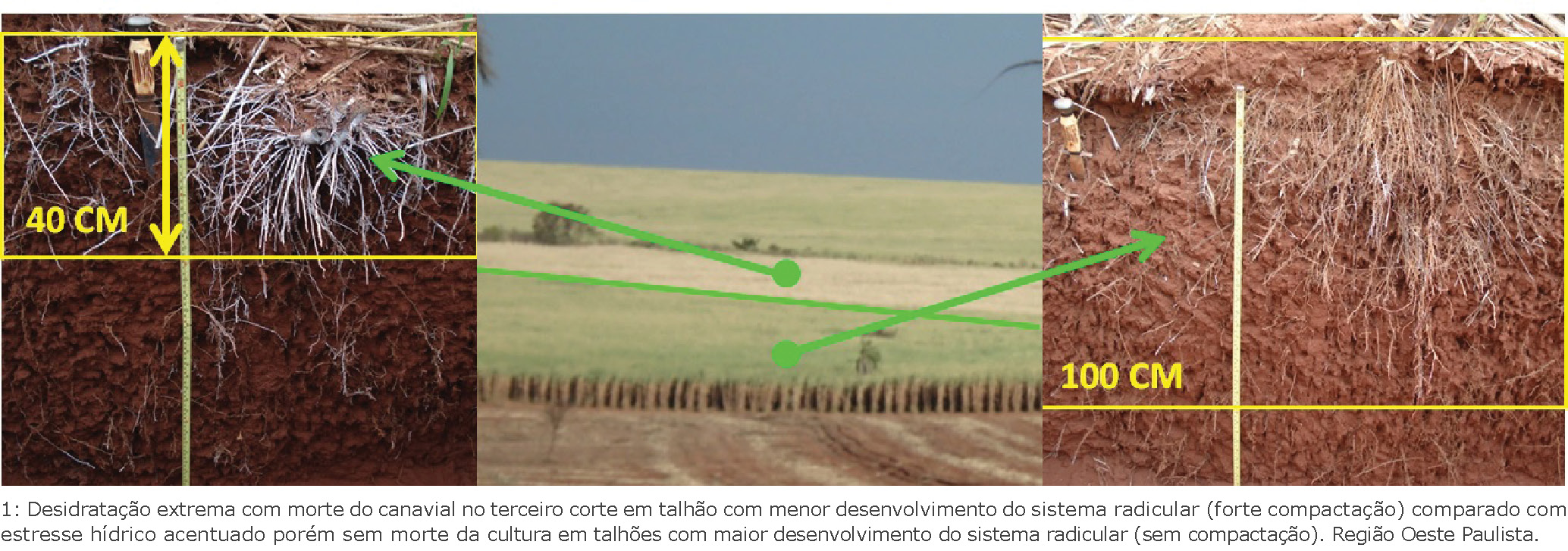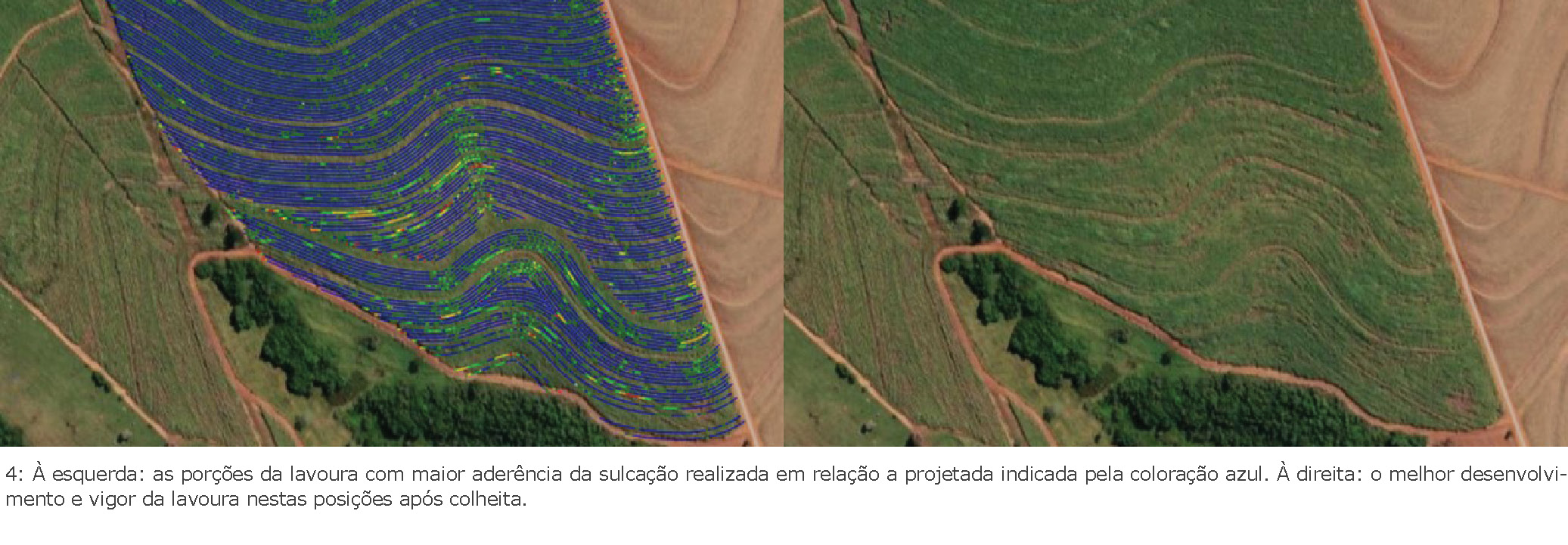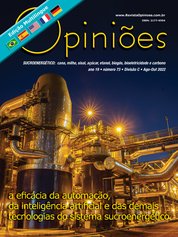Jairo Antonio Mazza
Diretor da Athenas Agrícola
OpAA73
A automação viabilizando o manejo dos solos
Em discussões técnicas que comparam a evolução temporal da produtividade dos grãos com a da cana-de-açúcar, na última década, os resultados são muito desfavoráveis ao setor canavieiro. Enquanto no manejo de solos do setor de grãos, cada vez mais, agregam-se práticas de construção da fertilidade do perfil de solo e plantadoras/colhedoras de dezenas de linhas das culturas, implicando redução da compactação e, ambas, resultando no incremento do sistema radicular das plantas, a cultura da cana-de-açúcar é submetida à intensificação da compactação, com extrema redução do sistema radicular. Adicione-se que, nessa comparação com o setor de grãos, a produção a ser retirada das lavouras de soja é de 3 a 5 t/ha, a de milho é de 7 a 10 t/ha e a da cana-de-açúcar é de 70 a 100 t/ha.
Quanto à cultura canavieira, no antigo cenário de colheita, corte manual com despalha a fogo, o conjunto de colheita, constituído pela carregadora e caminhão ou trator com compartimento de carga, transportava, em uma passada, a produção de cinco linhas de cana.
No novo cenário, o conjunto “colhedora + trator com transbordo(s)” trafega nas lavouras linha por linha, posicionando por entrelinha duas vezes a esteira da colhedora e duas vezes o rodado dos transbordos, ou seja, dez vezes mais, procedendo à colheita e transporte de alta densidade com cana picada das linhas individuais. Saliente-se, ainda, que o período da colheita da cana-de-açúcar estendeu-se para meses de maior umidade no solo (março/abril e novembro/dezembro).
Assim, significativas diferenças entre as colheitas do período com despalha a fogo e sem despalha a fogo, embora atualmente com expressivo e inquestionável ganho ambiental, potencializaram exponencialmente a compactação do solo, implicando drástica redução do desenvolvimento do sistema radicular, resultando em menor infiltração das precipitações, com incremento do déficit hídrico pelo menor aproveitamento das precipitações, menor utilização dos nutrientes contidos no solo e proveniente das fertilizações, maior impacto negativo das pragas de solo e menor eficiência do controle de ervas daninhas, pela lentidão do sombreamento das entrelinhas, resultando no decréscimo da produtividade e longevidade das lavouras. Soma-se, ainda, pela extrema redução da condutividade hidráulica da superfície do solo, uma maior produção de enxurrada, tornando obsoletas as práticas de conservação do solo e da água, baseadas exclusivamente em terraceamento, especialmente os terraços não transponíveis pelo sistema mecanizado (não passantes).




Portanto, atualmente, o princípio básico a ser adotado para o maior desenvolvimento do sistema radicular e a melhor conservação do solo e da água é a adoção de projetos de sistematização que permitam o posicionamento do rodado (esteiras das colhedoras e rodados dos transbordos) exatamente no centro das entrelinhas das plantas, através de tecnologia de piloto automático, levantamentos planialtimétricos detalhados exequíveis em larga escala e software de geoprocessamento (SIG), agregando-se também informações morfológicas, físico-hídricas e químicas dos perfis de solos.
Aliando-se ao objetivo do estímulo e preservação de maior desenvolvimento do sistema radicular, as áreas com projetos de alinhamentos mais retos ou de arcos suavizados devem ser posicionadas para colheita nos extremos da safra, terço inicial e terço final, uma vez que, nesses períodos, os solos se encontram com umidade e, portanto, com máxima friabilidade, ou seja, maior suscetibilidade à compactação. As áreas com projetos de maior angulosidade, sulcações em arcos mais fechados com tendência ao nível, devem ser posicionadas em meados de safra, uma vez que, devido à presença de menor umidade, os solos se encontram com a máxima coesão e, portanto, menos sujeitos a níveis severos de compactação.
Concomitantemente a esses critérios a serem adotados no planejamento e com o objetivo de otimização pela cultura da cana-de-açúcar do consumo da água advinda das precipitações, devem ser alocados solos de CAD (capacidade de água disponível) intermediária no início de safra, solos com CAD baixa em meados de safra e solos com CAD alta e de menor suscetibilidade à erosão no final de safra, respeitando-se, dessa forma, o critério de otimização da água disponível nos perfis de solos e o coeficiente de consumo de água da cultura canavieira (Kc). A partir dessas definições, são alocadas as variedades, permitindo que possam expressar um maior percentual de seu potencial genético.
Recomenda-se, então, que o planejamento do manejo da cultura da cana-de-açúcar seja iniciado pelo planejamento da colheita, que é efetivado associando-se um conjunto de áreas, se possível com proximidade geográfica e com as características adequadas (solo, sistematização e Kc), definindo-se os blocos de colheita.
Saliente-se que o deslocamento das áreas durante os meses de safra (teoria do terceiro eixo), para obtenção de maior idade cronológica dos canaviais, com possíveis incrementos de ATR/t de cana, poderá ser adotado, desde que se preservem os princípios considerados, ou seja, caso sejam deslocadas áreas com solos de CAD baixa e/ou de sistematização com maior angulosidade; no ano seguinte, pode ser bastante elevado o impacto negativo na brotação e no vigor das soqueiras e, consequentemente, na produtividade.
Posteriormente ao planejamento da colheita, elabora-se o plano de plantio, baseado nas características pedológicas. Na sequência, efetua-se o planejamento do preparo do solo, adotando-se tecnologias que busquem, fundamentalmente, o máximo aprofundamento do sistema radicular, através da eliminação eficiente de restrições físicas e químicas, que coincidem com a máxima infiltração de água das precipitações.
Recomenda-se a utilização de coberturas vegetais de rápido desenvolvimento, principalmente em solos de maior erodibilidade, admitindo-se também coberturas verdes com menor velocidade de desenvolvimento, desde que em solos de menor suscetibilidade à erosão. O preparo de solos em profundidade, que incrementa a condutividade hidráulica do perfil, deve ser realizado preferencialmente em faixas, com ou sem meiosi, complementando com elevada eficiência a prática mecânica de conservação do solo e da água baseada exclusivamente no terraceamento.
Em função da época, das características morfológicas e físico-hídricas dos solos e das características topográficas, aliadas à cobertura vegetal e, especialmente, à adoção do preparo em faixas, pode-se minimizar, ou até mesmo substituir, a adoção do terraceamento.
Com esse novo conceito de ordenação do planejamento agrícola, realizado com antecedência mínima de 3 a 5 anos, otimiza-se a adoção das tecnologias disponíveis e o desempenho das operações agrícolas, tanto no aspecto quantitativo como no qualitativo.
Quando adotado o planejamento na sequência proposta: colheita, plantio e preparo, obtém-se a maximização da eficiência hídrica, quer pela maior infiltração das precipitações no solo, quer pelo maior desenvolvimento do sistema radicular da cana-de-açúcar, potencializando-se as demais variáveis, possibilitando que expressem positivamente seus efeitos na obtenção de melhores resultados operacionais, agronômicos e ambientais.




